According to information from the manufacturer, Rawmid Classic RCM-02 is a universal device that is not limited to just the process of making chocolate. Experimental tests of its predecessor confirm this. This machine can be used not only to create delicate chocolate, but also for kneading dough, grinding coffee and spices, as well as for preparing flour from cereals, nut butters, urbechi, tahini and fruit and berry purees. Let's take a look at granite millstones in action!
Characteristics
| Manufacturer | Rawmid |
|---|---|
| Model | RCM-02 |
| Type | melanger/urbech-maker |
| Country of Origin | India |
| Guarantee | 1 year |
| Peak power | 200 W |
| Speed Modes | 1 speed |
| Timer | No |
| Number of revolutions per minute | 80 |
| Case color | white |
| Millstone material | granite |
| Work bowl material | granite bottom and stainless steel walls |
| Working volume of the bowl | 2 l |
| Maximum permissible weight of solid products for processing | 1 kg |
| Accessories | protective cover, spatula, dough mixer attachment, scraper attachment for coconut pulp |
| Weight | 11.2 kg |
| Dimensions (W×H×D) | 36×50×29 cm |
| Network cable length | 1m |
Equipment
The device is supplied in two boxes: an outer one made of durable corrugated cardboard, designed for protection during transportation, and an inner one, which is more familiar to the end user. The information contained on the inner box allows you to familiarize yourself with the appearance and features of the Rawmid Classic RCM-02 melangeur, helping the user form a first impression of the product.
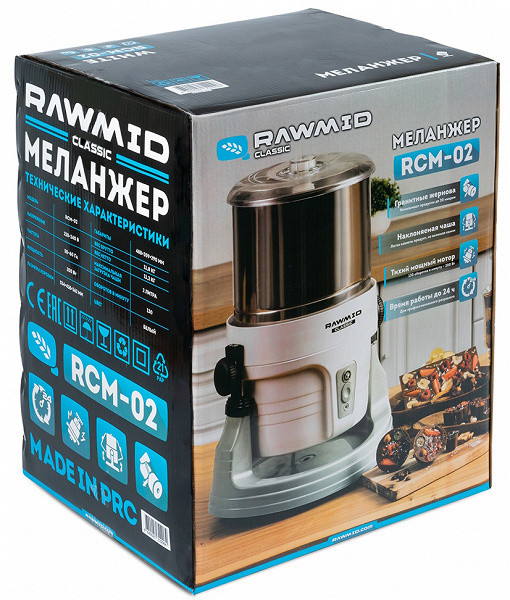
After opening the box we found:
- Melanger body with installed bowl and millstones.
- A spatula, a scraper attachment and a dough mixer attachment.
- The lid.
- User manual, warranty card and advertising leaflet.
Each melangeur component and its accessories were packed in separate plastic bags. Inside the box, several thick inserts and corrugated cardboard seals were used to ensure a secure fit for the device. The packaging creates the impression of being reliable and capable of maintaining the original appearance and properties of the melange during delivery from the manufacturer to the final buyer.
At first sight
The first thing that catches your eye is the weight of the Rawmid Classic RCM-02 melangeur: it is more than 11 kg. This is understandable, since the device is made of granite and steel.
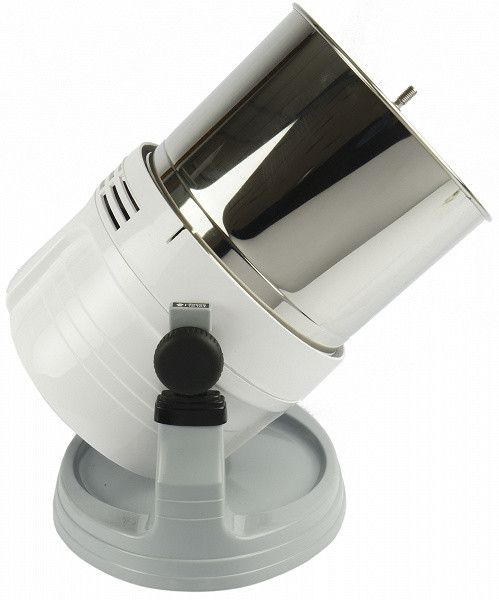
The body of the melangeur consists of a wide plastic base on which the motor block is located. In the center of the upper platform you can see a steel spindle with a screw thread on top. It is equipped with plastic and rubber gaskets at the bottom, which are in contact with the working bowl of the melangeur.

The motor is secured by two clamping locks.
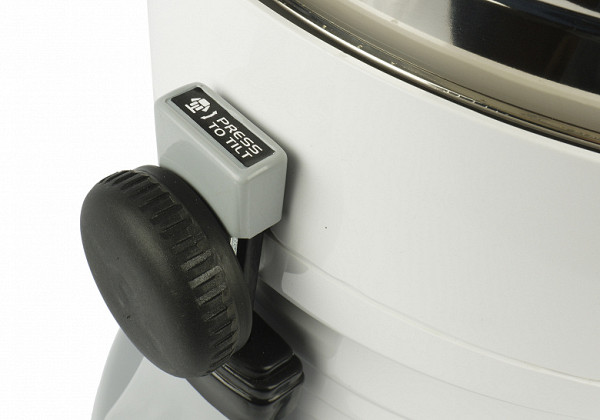
When you press the left latch, the engine compartment and the attached bowl may tilt. The bowl can be set in several positions: approximately 45°, 90° and 120°, which greatly simplifies the process of pouring the finished product into a storage container.
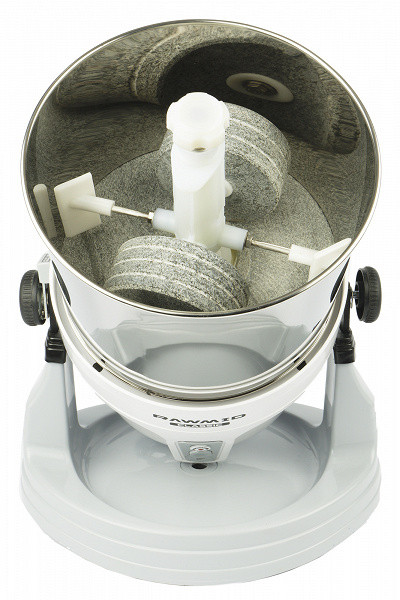
At the bottom of the melangeur there is a noticeable thick ring, probably a metal counterweight for stability. This ring has four strong rubber feet that provide a firm fit to the table surface. In general, the melangeur stands stable and does not show a tendency to move under the influence of vibration.
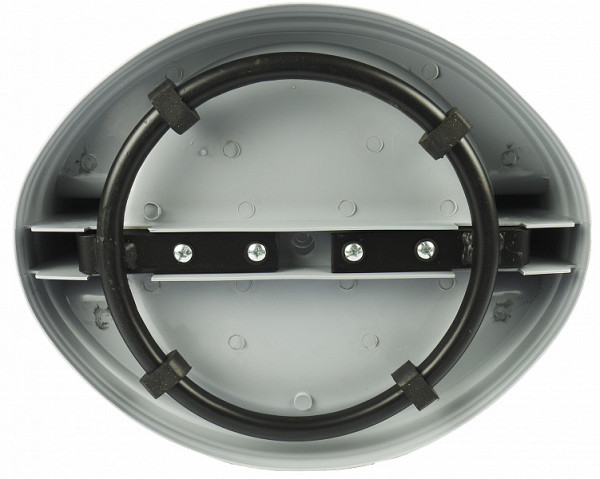
Now let's move on to inspecting the most important element — the working container and millstones. The container is made of durable stainless steel and granite and weighs 3.04 kg. In the center of the container you can see an axis intended for installing nozzles.
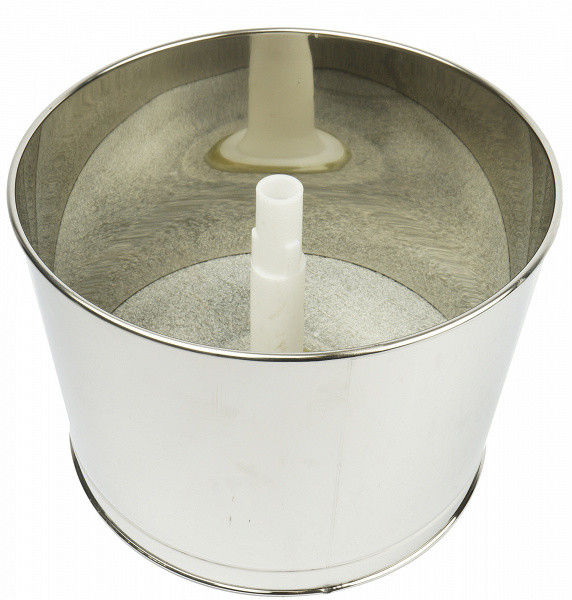
Let's pay attention to the bottom with a slight roughness. I would also like to note the radial groove and several spiral grooves present on the surface. Some believe that these grooves contribute to more efficient grinding of the product, since the lower millstone in a standard design should have a variety of grooves of different depths and directions.

All seams and joints are carefully, and in some places abundantly, sealed.

The millstone attachment has an interesting design that allows you to adjust the location of the scrapers in the bowl.
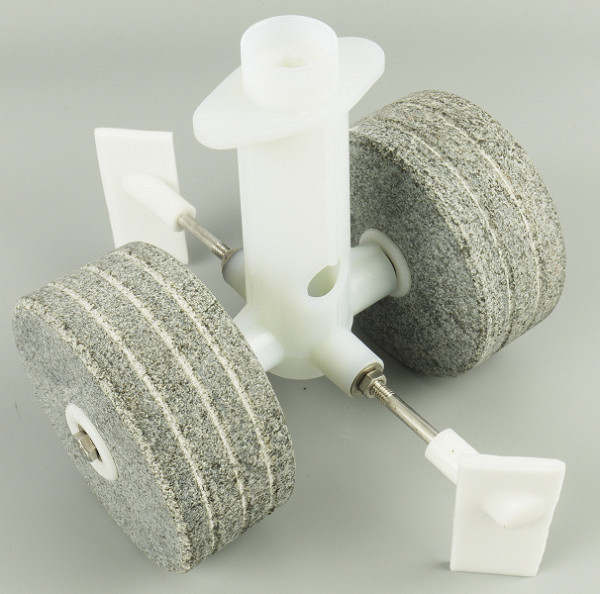
The millstones are granite, with three grooves on the working surface and beveled edges.
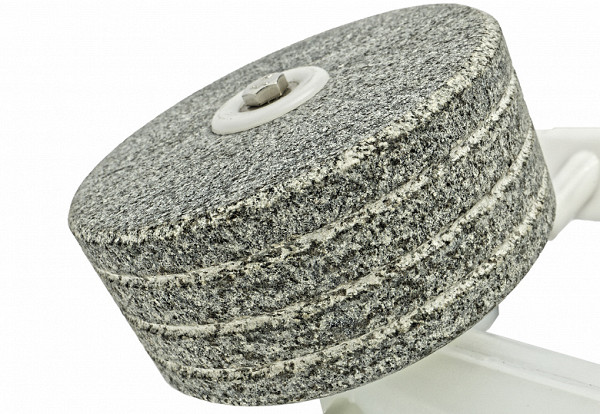
Installing the attachment into the bowl occurs naturally: after installing the container on the motor block, you need to place the millstone holder on the central protruding part of the bowl and connect it to the spindle. The scrapers, made of durable plastic, can be tightened with nuts to install closer to the walls of the bowl or vice versa. These scrapers play a key role in increasing the efficiency and speed of grinding the product by collecting it from the walls and directing it under the millstones.
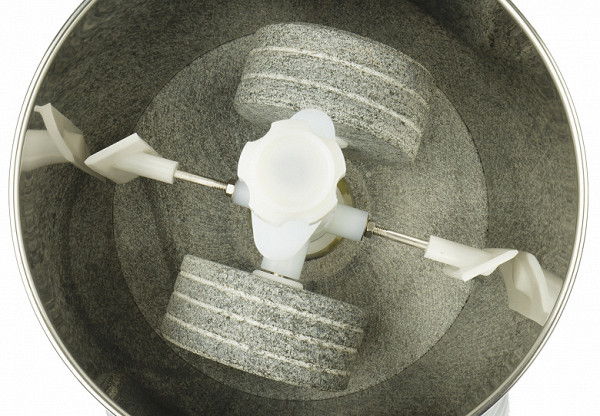
After installing the millstones, you should tighten the upper lock, placing it with the spring down. The more you tighten the spring, the more the millstones will be pressed to the bottom of the bowl.
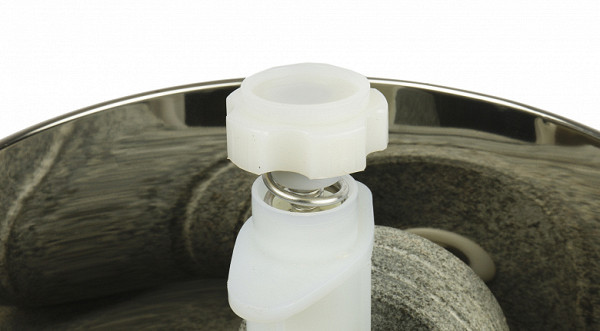
The design is equipped with a lid that is put on top. It is worth noting that the lid is intentionally put on a little loosely to ensure the free release of vapors when the mixture is heated. The lid is transparent, which allows you to observe the process in the melangeur.
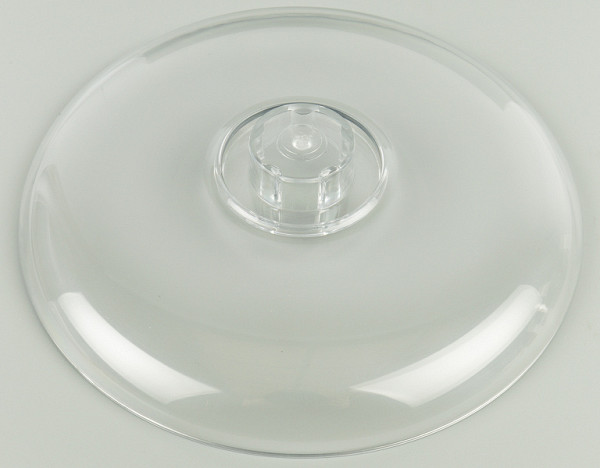
The Rawmid Classic RCM-02 melangeur comes with two additional attachments. One of them is a coconut scraper. It is a plastic piece with sharp serrated blades set into the edges of the top.

The dough mixer attachment includes two blades located at different heights from the bottom of the container. One of the blades is located almost at the bottom, while the second rises by 2.5 cm. The material used to make the nozzles is significantly thick (2.5-3 mm) and looks very durable.
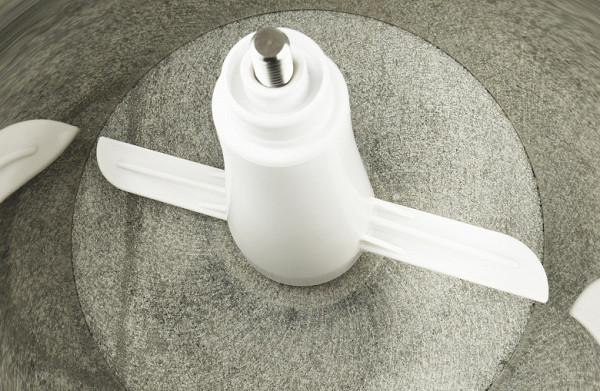
The device is equipped with a plastic spatula, which is useful during operation for removing the finished product or removing adhering residues from the walls and protruding parts of the nozzles.

Apparently, the Rawmid Classic RCM-02 melangeur is a carefully designed and well-made device. So we can't wait to study the instructions and start hands-on experiments to test our first impressions in practice.
Instructions
Before you start using the melangeur, we strongly recommend that you take 10-15 minutes to read the user manual. This 28-page A4 document is printed in full color and is made from durable, glossy paper to ensure durability and ease of use over multiple uses.
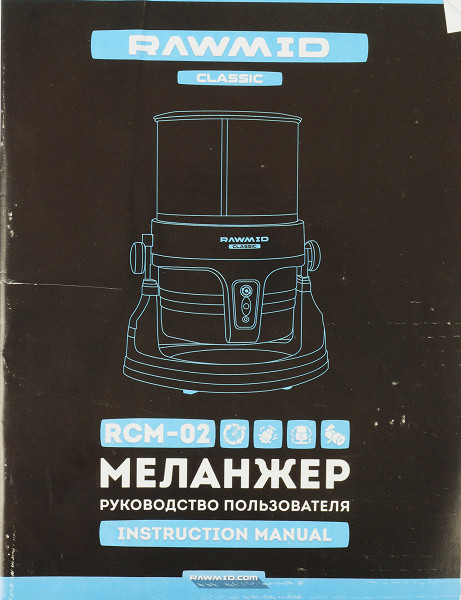
The user manual contains useful answers to a wide range of questions related to the design and operation of the melangeur, its scope, as well as safety measures. Particular attention is paid to a detailed description of the chocolate making process, including step-by-step instructions, specific tips and cautions to help avoid mistakes during preparation. In addition, the guide presents several recipes for chocolate and flaxseed urbech, which allows you to diversify your culinary experience and gain new taste sensations.
Control
The Rawmid Classic RCM-02 melanger is controlled using a large central “On/Off” button located on the engine compartment body. First of all, you need to install a steel bowl on the central spindle of the base, and then select and install the desired attachment — a millstone, a dough mixer, or for grating coconut. After this, you need to secure the nozzle using the upper lock, lowering its spring down. After closing the lid, you can start the device by pressing the “On/Off” button. To turn off the melanger, you should also press the same button again.
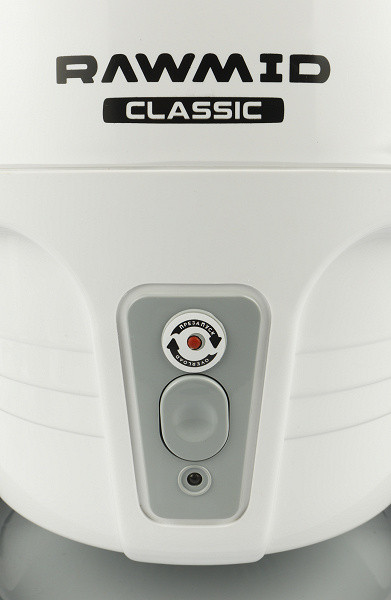
Above the central button there is a small red “Restart” button, and at the bottom of the case there is an indicator for connecting to the electrical network. This indicator lights up bright red when the appliance is plugged into an outlet.
Exploitation
In addition to thoroughly washing all removable parts and accessories, before first use it is recommended to run the melanger for one hour with 500 ml of vegetable oil or 200 g of sugar. This procedure is necessary to remove fine stone dust from the millstones. Since sugar is a more affordable option, we have seen sugar turn into fine powdered sugar within an hour when combined with granite dust.
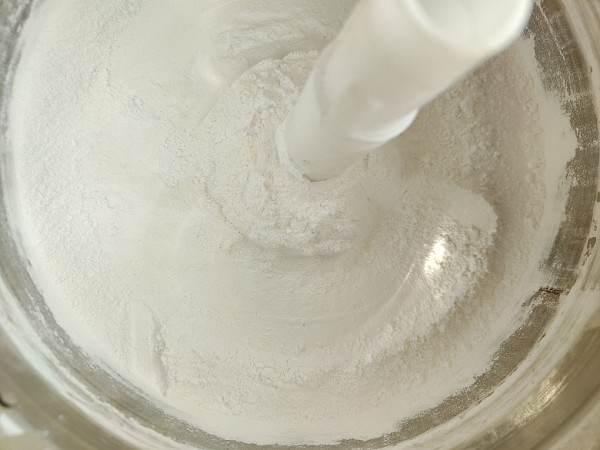
After we have ground the sugar to dust and thoroughly washed all parts and accessories, you should pay attention to the following points before using the Rawmid Classic RCM-02 melangeur:
- Washing and Drying: It is important to thoroughly wash and dry all removable parts and accessories. They can be rinsed under water and dried thoroughly with a dry cloth.
- Preparing food: Before processing dry foods, they must be pre-soaked. This is especially important since handling dry foods can cause granite stones to wear out quickly.
- Operation: Operating the melangeur is very simple — just one control button. Assembly and disassembly is also intuitive. However, there are several nuances that are worth paying attention to:
- Bowl tilt function: This function can only be useful when working with bulk products, the volume of which exceeds 500 ml or even a liter.
- Minimum volume of product: It is recommended to process at least 400-500 grams of product to avoid unnecessary wear of the millstones. It will be even easier to work with a kilogram of food.
- Adjusting the upper lock spring: The spring must be tightened as the product is crushed, starting with the free weight of the millstones. This will ensure that the burrs are pressed correctly to the bottom.
- Positioning of the scrapers: It is important not to place the scrapers too close to the sides of the bowl to avoid scratching and contaminating the food.
These recommendations will help you use melange effectively and keep it in good condition for a long time.

- During our first two tests, we noticed a strong smell of burning grease, which raised some concerns. However, after the third and fourth tests, the hope increased that the smell would decrease and the user could enjoy the chocolate aroma
- The author is critical of the additional functions of the device, but it should be noted that the function of kneading dough in a melangeur works well. Although we wouldn't recommend preparing dense dumpling dough in it, soft yeast dough and unleavened dough can be easily prepared using the dough mixer attachment. If you need to prepare a large amount of dough, for example for Christmas gingerbread, the Rawmid Classic RCM-02 melanger can be useful.
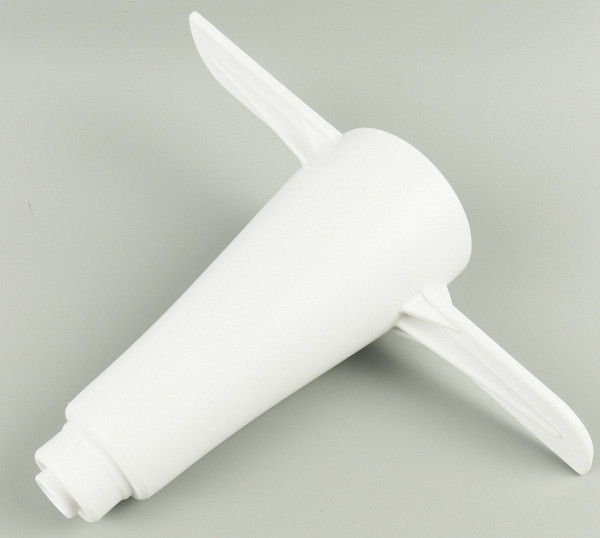
- During the operation of the melangeur, the bowl actually oscillates and vibrates, but the body of the device remains securely installed on the table, which indicates its reliable design.
- The engine compartment heats up during operation, and the body of the device becomes warm. This helps maintain the optimal temperature of the product, which is especially important for the chocolate making process. The mass is heated to the required 40-42°C, which ensures the correct chemical conching processes.
In general, we did not identify any other significant features when using the Rawmid Classic RCM-02 melangeur. If you have any questions, the author will be happy to answer them in the comments.
Care
Caring for melangeur is simple and effective if you follow a few simple rules:
- Hand wash only, dishwasher is not suitable for washing the bowl and grinders.
- Clean the device after each use, preventing food from drying out on the walls of the bowl or millstones.
- Use a soft sponge and non-aggressive detergent for cleaning.
- To remove greasy or sticky food residues such as nuts or chocolate, it is recommended to use a regular sponge with detergent. You can also use a small brush, such as a toothbrush.
The only difficulty may arise from the heavy bowls and millstones, so you need to be careful when cleaning or involve a stronger family member in this.
Our measurements
The actual power of the Rawmid Classic RCM-02 melanger turned out to be within the declared limits, fluctuating between 175 and 186 W. It is interesting to study the power consumption of the device when preparing various dishes:
- In one hour of grinding sugar, the melanger consumed 0.174 kWh.
- For two hours of grinding sesame grains — 0.444 kWh.
- For an hour and a half of cooking cedar urbech — 0.278 kWh.
- Conching chocolate for 10 hours 40 minutes required 1.885 kWh.
The noise level during operation of the melangeur is quite high, which creates problems when being in the same room with the operating device, especially at the beginning of the grinding process. However, the nice thing is that nut and grain butters cook relatively quickly — within 1-3 hours.
Practice tests
During the tests, we will prepare several dishes to evaluate the technical characteristics of the melangeur, the ease of its operation and the quality of grinding products of different densities and degrees of hardness.
Tahini (sesame paste)
To get acquainted, we decided to do a simple test — white sesame tahini. We took 500 g of sesame seeds and pre-dried them for two hours in an oven at 75 °C with convection.
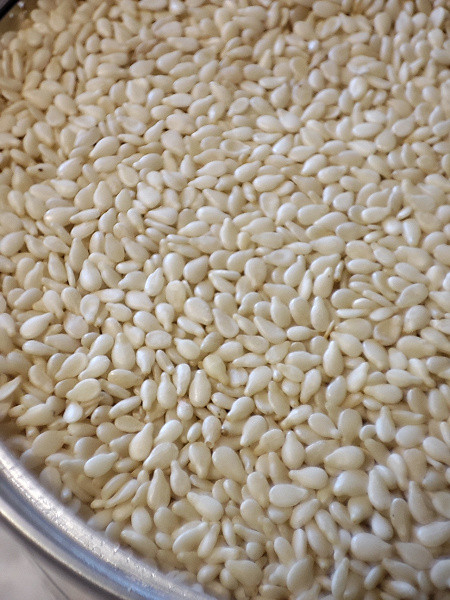
Then, following the instructions in the instructions, about a third of the volume of grains was poured into the bowl.
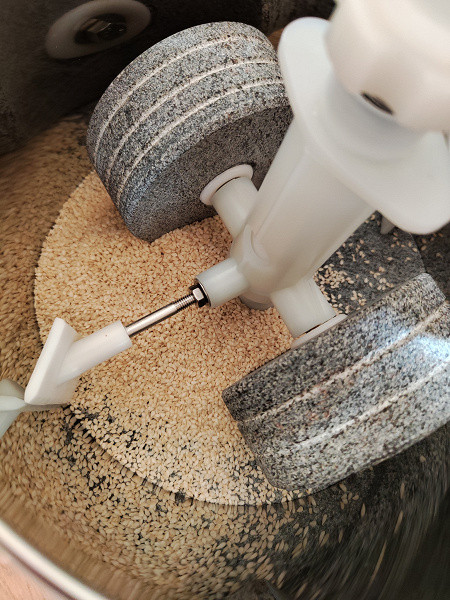
After 15 minutes, the grains were already ground into a heterogeneous but sticky mass. We added another third of sesame seeds, carefully watching how evenly and en masse they went under the millstones. In the process of observing the work of the melanger, we discovered that this is an extremely sticky activity. Comparisons with the noise of a washing machine and the most popular ASMR video are simply inappropriate. Therefore, we had to be distracted by willpower and leave the device alone.
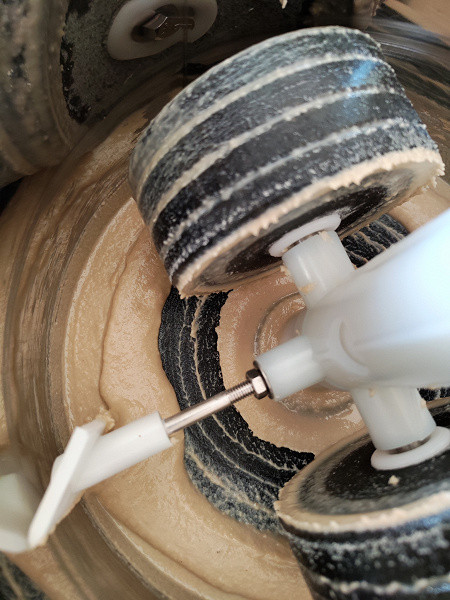
After about an hour, a liquid mass had already formed in the container, but at the ends of the millstones and on the central axis there remained a certain amount of crushed grains, but not completely ground into a liquid mass. We used the included spatula to scrape them off and left the melangeur alone for another hour.
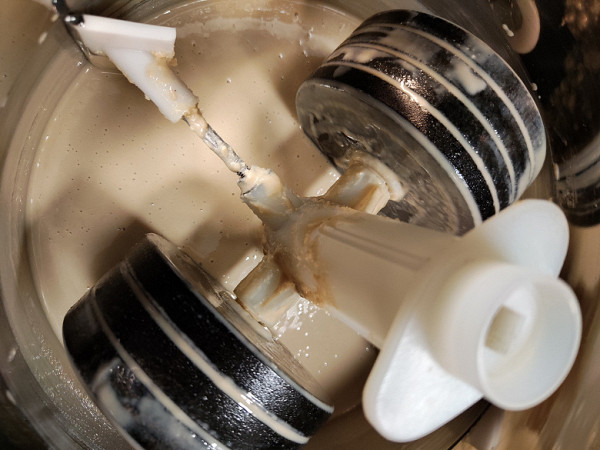
In two hours, the sesame was reduced to a smooth, liquid, shiny mass without a single sign of crumbs or grain residue.

Result: excellent.
Pine nut paste
Pine nuts themselves are a delicacy, but when they are crushed into tiny particles that are indistinguishable on the tongue, they turn into a substance rich in nutty flavor and incredibly delicate in consistency. We added about a third of the nuts and started the melanger. Within a minute we watched the nuts quickly grind and turn into an elastic mass. Then we added the remaining nuts and covered the bowl with a lid. In total we processed 500 g of product.

After about fifteen minutes, the mass became liquid, but individual fragments of nuts could still be discerned in it. After an hour, the paste seemed to be ready, but after tilting the bowl, it was clear that the particles were still patchy. We decided to tighten the upper spring to press the millstones a little closer to the bottom, and left the device to work for another half hour.

After an hour and a half from the start of grinding, the nut crumbs turned into a shiny and liquid mass, richly smelling of pine nuts. The paste was extremely flavorful, slightly sweet and incredibly silky in texture.

Result: excellent.
Chocolate
After getting acquainted and the first experiments, we move on to the most interesting part — making chocolate. A careful study of the instructions, and especially the chapter on proper cooking of chocolate, raised some concerns about the complexity of the process. However, even stages with such complex names as conching and precrystallization turned out to be not so scary in practice, although they require certain skills and attention to detail and conditions. Well, the road can be mastered by those who walk, so we are ready to share the experience of beginning chocolatiers.
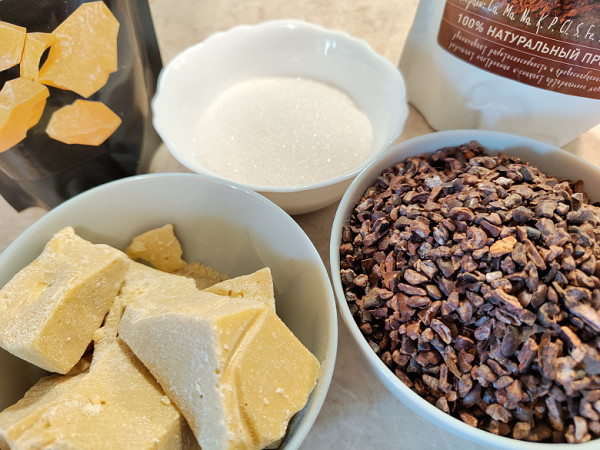
We used the classic recipe, slightly adjusted to suit our taste:
- cocoa butter — 200 g
- cocoa nibs — 250 g
- granulated sugar — 130 g
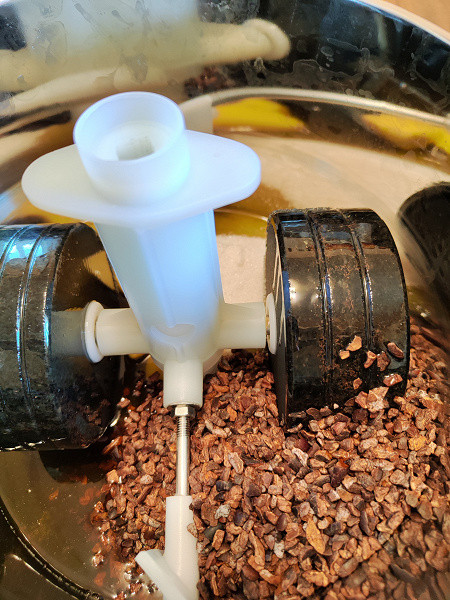
After half an hour, the mass became liquid, but grains of sugar were felt even after an hour of operation of the melanger. At the same time, we cleared the protruding parts of the structure, such as the axles of the millstones, scrapers and their axles, from the frozen chocolate mass.
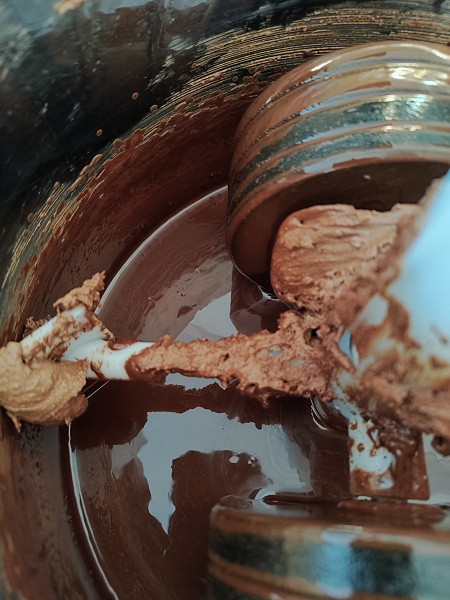
After two hours, we tightened the spring of the upper lock so that the millstones fit more tightly to the bottom of the bowl. After 10 and a half hours of conching, the texture of the chocolate mass achieved the desired result — it became absolutely smooth, glossy and silky. The smell that filled the room was simply incredible. However, the pleasure was slightly hampered by the smell of hot engine grease, which was also mixed with the aroma of chocolate. We hope that as the device is used, this feature will disappear.

During operation of the device, the case became noticeably warm. The temperature of the chocolate after 10 hours of grinding reached 42 °C.
Next, using a pyrometer and operating instructions, we began the process: poured the chocolate into a bowl and quickly cooled it with constant stirring to 27 °C, which corresponds to the precrystallization stage. This stage allows you to give the chocolate the correct structure and appearance: the chocolate will become glossy, crispy and pleasant to the taste.
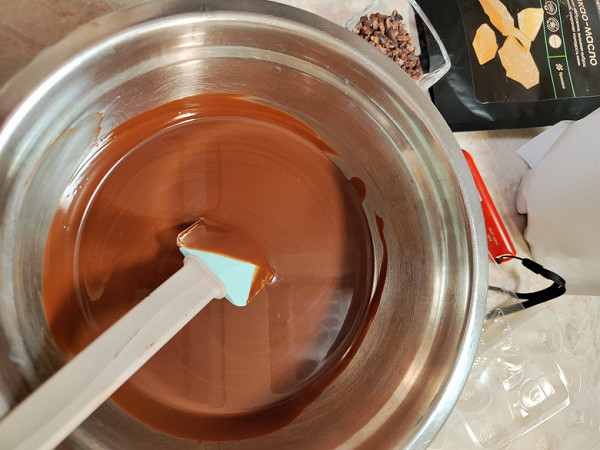
Then we heated the chocolate in a water bath to 31°C and poured it into molds
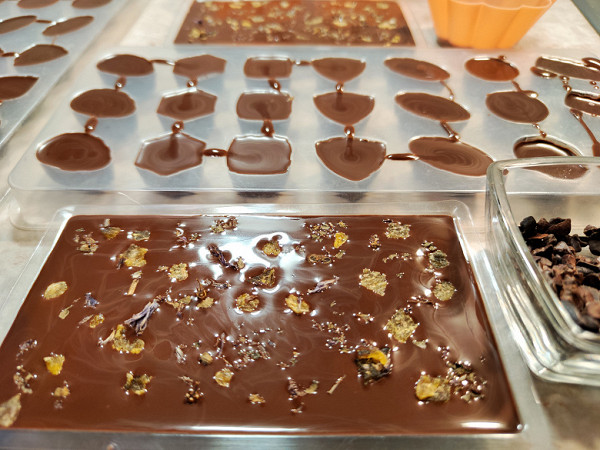
Unfortunately, we were unable to create special conditions for cooling, so we took simple measures: we opened the window wide to make the room cooler. After an hour, we closed the window and left our candies and chocolate to harden into their final look and texture.
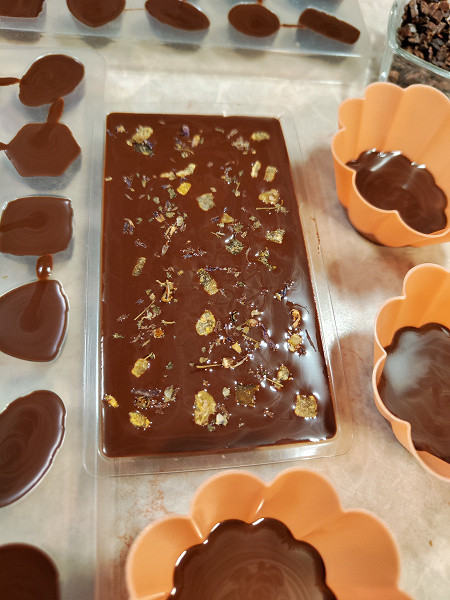
The chocolate turned out delicious — extremely delicate, with a silky structure and enveloping taste.
Result: excellent.
Kurnik
As the last step, we decided to test an additional function of the melanger — kneading dough. Having inserted the dough mixer attachment, we added 500 g of flour, 250 ml of kefir, 170 g of melted butter, as well as a teaspoon of salt, sugar and soda into the bowl.
The melanger coped with the task quickly and efficiently: in less than three minutes we received a well-kneaded lump of dough weighing 930 g.
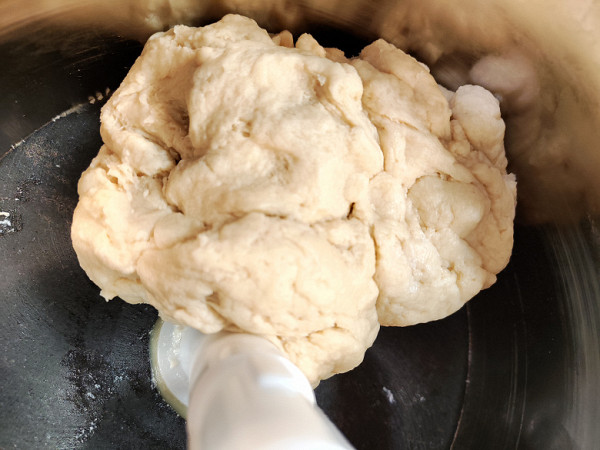
We put the dough in the refrigerator and started filling.
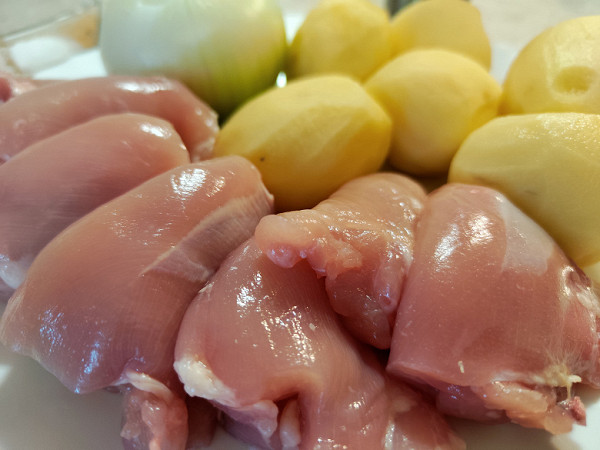
Finely chopped potatoes, chicken thigh fillets and a large onion. Season with salt and pepper and mix thoroughly.
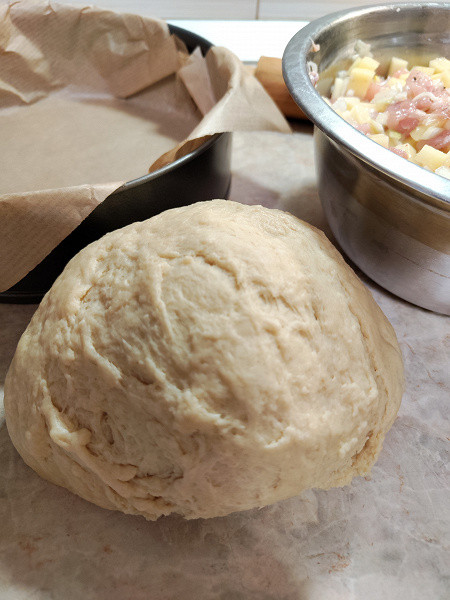
We lined the pan with parchment, rolled out most of the dough, laid out the filling, covered the top with a small circle of dough and pinched the edges. Not very difficult, but looks great.
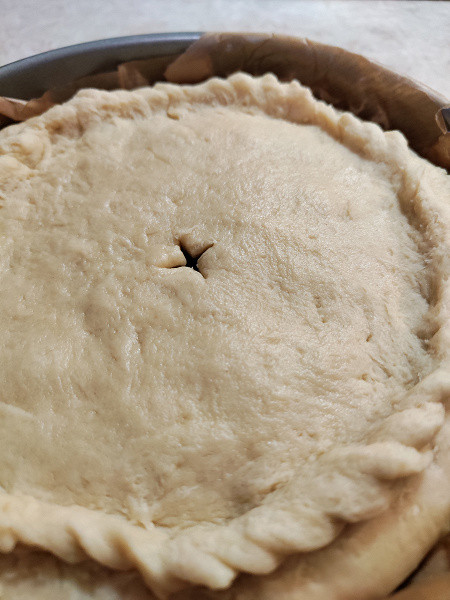
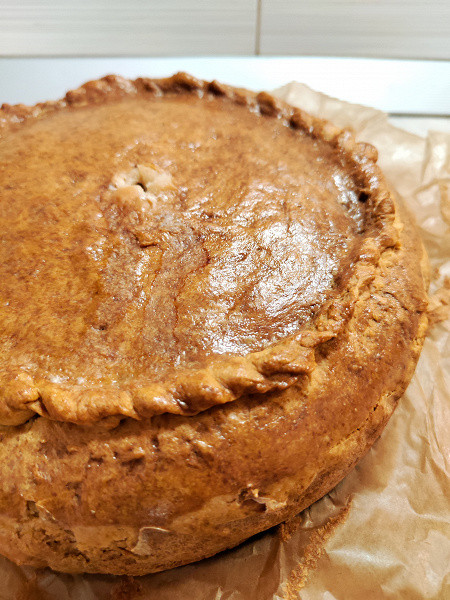
Without much effort, using a melangeur, we prepared a wonderful, rich pie.
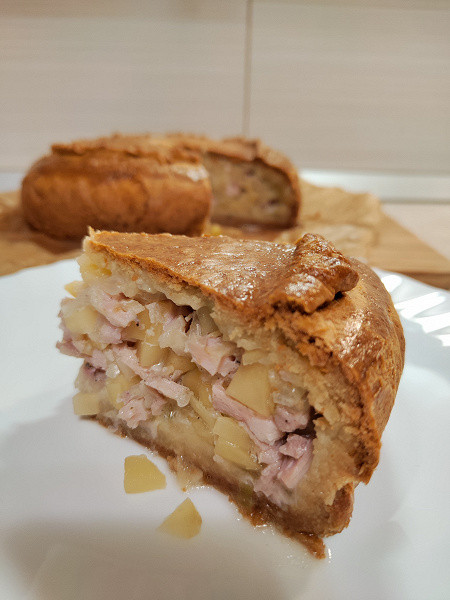
Result: excellent.
conclusions
Melanger Rawmid Classic RCM-02 fully met our expectations. We highlight its high-quality performance, ease of use and extensive functionality. Although it is not intended for making soups, it is capable of turning boiled ingredients into a smooth soup puree. In addition, the melanger creates the most delicate chocolate, pastes and sauces from various products, as well as nut and grain pastes. It also kneads dough well, although frequent use for grinding grains is not recommended. The design of the device is calm and discreet, and the granite millstones are durable and wear-resistant. The manufacturer claims that these qualities will allow the Melanger Rawmid Classic RCM-02 to be used for a long time.
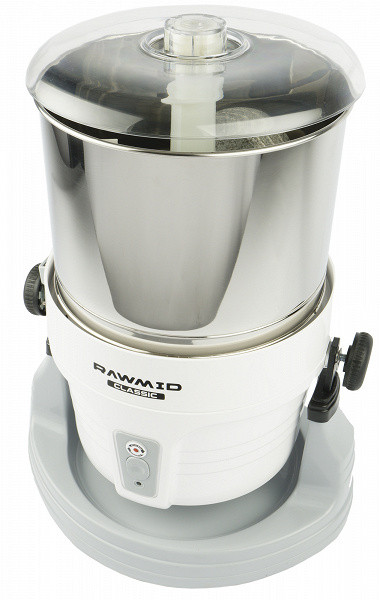
All tests were rated “excellent”, not because of the author, who is an experienced cook, but because of the pleasure of working with the melangeur. This device is extremely easy to use and operate. Caring for it is also easy, except for the heaviness of the bowl and millstones. Based on our experiments, we confidently recommend this device to anyone interested in making chocolate, grain and nut spreads, as well as those who strive for culinary discoveries and care about healthy eating.
Pros:
- ease of operation, management and maintenance
- grinding fineness to the smallest particles measuring 15-20 microns
- wear-resistant granite millstones
- availability of additional attachments
- advanced functionality
Minuses:
- heavy weight of the millstones and bowl
- To make high-quality chocolate, you need to scrupulously follow the technology, which can be difficult for beginners
